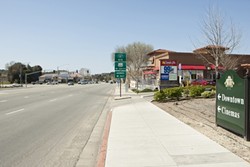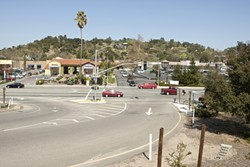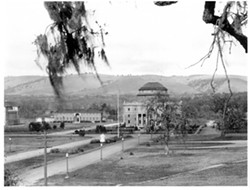Nobody can call Atascadero a slum.
Atascadero offers quality housing, ample services, and a relatively high standard of living. No gangs terrorize its streets, and no festering industrial hazards threaten the health of its residents. Yes, Atascadero is a pretty typical American town.

- PHOTO BY STEVE E. MILLER
- DOWNTOWN? : Even within a half mile of Colony Square—the centerpiece of what Atascadero defines as its downtown—commercial development is low-density and dominated by national chains.
Atascadero also suffers from commercial sprawl, traffic problems, and disjunctive urban planning. The police station features a giant radial-arch window trimmed in pink and flanked with flagstone, an example of the kind of tacky design that permeates downtown. Strip malls and box stores dominate a main arterial where cars whistle along five lanes of highway dressed with symbolic bike lanes. Most noticeably, vacant storefronts line the downtown area while box stores continue to spawn at the edge of the city.
Yes, Atascadero is a pretty typical American town.
But tucked between a dynamic and growing wine capital, an iconic California port town, and San Luis Obispo (Oprah’s favorite thing after Trader Joe’s bite-sized ice cream cones), Atascadero stands out for its planning chaos and unmarketable veneer. The economic figures bear out that consumers avoid Atascadero, and its own residents choose to spend their money in other cities. The rest of the North County grew right through the recession and now threatens to leave Atascadero behind.
The economic problems of the Colony, as residents call it, stem from a weak commercial core loosely clustered along the city’s main drag: El Camino Real.
The ubiquitous city father
Although Atascadero seems simply the product of poor planning, nothing could be further from the truth. In 1913, a progressive magazine publisher named E.G. Lewis bought a massive North County ranch to build a utopian colony based on early feminist ideals. The plans called for a fastidiously regimented city of about 30,000—the first in California designed to accommodate the motorcar.
Lewis held popularity among middle class women in the early 20th Century to an extent not again seen until the era of the daytime talk show host. Yet the controversial and combative magnate accumulated an equal number of detractors who labeled him an opportunistic charlatan. Prior to the founding of Atascadero, U.S. Postmaster General George Cortelyou made Lewis the target of 14 mail fraud indictments over his use of the post to run his banking-by-mail operation.
“All 14 indictments were either dismissed, acquitted, or thrown out,” explained Tom Lewis, an Atascadero resident and grandnephew of E.G. Lewis. “They were ridiculous.”
In Atascadero, Lewis spearheaded the ambitious public works project that eventually became Highway 41 and began the process of planning an architecturally cohesive downtown. A prosperous colony sprouted from a tent city in just a few years.
“He brought in all the local experts of the time,” Lewis said. “Atascadero was designed with underground utilities. They planned its greenbelt; it had creek reservations, park areas. The civic center was done in Italian Renaissance architecture.”
The cost of trying to build a community in wartime, however, eventually mounted against Lewis. Atascadero entered the 1920s shouldering a significant amount of debt, while Lewis’ costly exploits and powerful enemies brought about his financial ruin. Leadership of Atascadero passed to Oscar Willett, who snaked control of the colony holding company through legal maneuvering. Willett promptly sold the Colony’s resources into private hands, reportedly pocketing the proceeds.
“The dream of what Atascadero was supposed to be was taken away,” Atascadero Historical Society President Jim Wilkins said. “If you take the dreamer out of the dream, it’s really hard for the dream to sustain itself.”
Fifty-four years passed before Atascadero incorporated as a city in 1979. By that time, the founding principles of community planning had eroded alongside many of the Colony’s historic structures. The state built Highway 101 right alongside El Camino Real in 1954, bisecting the downtown in a way that caused its smaller western side to decay. California officials exacerbated the city’s sprawl problem two years later by situating Atascadero State Hospital on the edge of town.
Unable to cluster around a downtown anchor, commercial growth stretched southward, eventually spreading so thin that gaps began to emerge along El Camino Real.
Leakage and capture

- PHOTO BY STEVE E. MILLER
- LAST EXIT : The Highway 101 ramp for downtown Atascadero dumps straight on to El Camino Real (below). This stretch of road ranks among SLO County’s most dangerous cycling hazards.
Urban planners use the terms “leakage” and “capture” to measure the retail potency of a commercial area. When residents of an area leave the community to buy goods and services, the amount of money spent within the area per person falls below the county average. The measured differential in taxable sales is called leakage. Capture measures the opposite: retail sales gained above the expected share per resident based upon what the county citizens spend in that commercial sector.
Cal Poly urban planning professor Vincente del Rio sent his students out to comb taxable sales receipts to find out how Atascadero fares in attracting retail shoppers. The study was a small part of a larger project to propose a conceptual redevelopment plan for the southern stretch of El Camino Real.
The numbers show that Atascadero struggles mightily to attract retail shoppers. The city’s strengths in building material stores and grocery outlets are consistently outweighed by poor sales in home furniture and appliances, automotive, restaurants, and general merchandise. Clothing sales register almost comically low, with the 2010 economic figures showing that Atascadero made less than $3 million in apparel sales out of $186.4 million countywide.
“I think that the low-density development that Atascadero has, the lack of a downtown, and the let-it-alone political posture along El Camino Real led to the city not having a center of gravity,” del Rio said. “There’s a lot of business that could happen there, but they’re losing it to other cities where it’s easier to shop.”
The logical relationship between Atascadero’s poor performance in some commercial sectors and its weak downtown may include a few interfering variables. The 28,310 residents of Atascadero make less money on average than the rest of the county, and perhaps they choose to spend discretionary income on home improvements instead of fashion. However, most people tend to agree that downtown sprawl severely limits Atascadero’s commercial potential.
“It’s hard to believe that this hodgepodge grew out of Lewis’s progressive planned community,” Atascadero planning commissioner Len Colamarino said. “It’s not well suited to attracting business.”
Atascadero has a lot of its hopes pinned on plans to build a Wal-Mart supercenter at the north end of town. The proposal originally came packaged with a separate retail component called the Annex. Atascadero promised to advance $2.5 million to bring the Wal-Mart development to fruition. Yet the Annex developers went insolvent during project review and lost most of the construction site to the bank. The City Council nevertheless approved the development with public wastewater funds securing some of the impact costs.
City officials expect construction of Wal-Mart to shore up a substantial portion of Atascadero’s commercial leakage problem. Warren Frace, Atascadero’s director of community development, believes the retail anchor will draw people to Atascadero, and that those people will then venture two miles downtown for entertainment and services.
“Most of the leakage is coming from discount retail,” he asserted. “A lot of it is just about keeping people from leaving town.”
Of course, downtown Atascadero’s woes go beyond sales receipts and tax ledgers. Other problems prove more visceral.
Traffic moves fast along El Camino Real, and some residents complain that police fail to enforce the speed limit. The box stores and strip malls along the main drag include massive setbacks, hiding retail outlets from pedestrians. To get to the visible retail on the other side of the street, a pedestrian must dodge highway traffic because the entire 2.5-mile southern stretch contains only one marked crosswalk. Finally, El Camino Real ranks among the least cyclist-friendly commercial corridors in the county.
“It’s a dare to use that road with a bicycle,” del Rio said.
Some people also cite lax regulation as a problem. Atascadero adopted a downtown plan in 2000 that calls for retail lessees to occupy street-level spaces downtown. However, the city stopped enforcing the plan provision several years ago and issued zoning exceptions, called special conditions, to many professional offices prior to that. Tribune Atascadero columnist Lon Allen recently complained that, though the city once adopted planning principles, it exercises its zoning power with lackluster zeal.
“Maybe I’m a tad cynical, but it seems to me, after years of observation of local government, a ‘special condition’ is whatever a local business wants,” Allen wrote on Feb. 25.

- PHOTO COURTESY OF CAL POLY
- CONCEPT TOWN : A 2012 Cal Poly urban design project imagined how Atascadero could revitalize south El Camino Real with the proper resources.
Atascadero admitted to giving up on enforcing the retail provision of the downtown plan when the recession hit. The City Council changed its zoning enforcement ordinance because the demand for office space significantly outpaced the demand for retail space.
“It became a political issue,” Frace said. “The council just decided that it didn’t make sense to have that hard a line.”
Enforcing existing planning policies would constitute a small step forward for downtown Atascadero. Encouraging private commercial investment in a sprawled-out commercial district seems monumental by comparison. Del Rio thinks it will take a unified community vision, strong political will, and no small amount of cash.
“It’s a big task, but I think Atascadero needs that,” he said.
Getting creative
Urban renewal occurs incrementally every day in cities across the nation. In the urban core, it rides the momentum created organically by gay-to-bohemian-to-hipster-to-yuppie gentrification trends. Atascadero seems unlikely to ride such a wave because, although it offers some of the county’s cheapest housing, it lacks the density necessary for that kind of turnaround.
“It would be great if the original plan had the Sunken Gardens surrounded by mixed use, but it didn’t,” del Rio remarked. “You can’t really change that.”
If Atascadero wants to revitalize its downtown, it will need a large infusion of public funding. For a long time, the state of California wrote checks for urban renewal projects, but that source all but dried up a few years ago.
“We’re going to have to be more creative,” Frace said.
Atascadero sometimes shows a willingness to try creative solutions. The city pushed the boundaries of the law when it used part of a federal emergency grant issued in the wake of the 2003 San Simeon Quake to build a downtown youth center instead of spending the cash on seismic repairs. The plan worked, however, and the Federal Emergency Management Agency (FEMA) let Atascadero keep almost the entire $12.3 million grant.

- PHOTO COURTESY OF ATASCADERO HISTORICAL SOCIETY
- THE DISTANT PAST : E.G. Lewis founded the Colony of Atascadero as a meticulously planned ideological community. This is how Colony Square looked in 1920.
Some Atascadero residents want to see that same creativity employed in capitalizing on the growth of neighboring Paso Robles. Paso succeeded in building a booming tourism economy around the public’s insatiable thirst for newer and more diverse wine appellations. Atascadero lacks the same viticultural resources, but Planning Commissioner Colamarino thinks the city could play a support role in courting tourists.
“Paso Robles is on the way to becoming a tourist trap,” Colamarino said. “Atascadero has the opportunity to participate in the wave of tourism that’s growing out of Paso.”
Atascadero can’t grow wine, but it can sell history. The Colony possesses iconic fixtures in both its 1918 Rotunda Building and E.G. Lewis’ Sunken Gardens, which the city started rebuilding almost a decade ago. Interesting structures exist within the city core. Atascadero made progress toward refurbishing some of the hallmarks of its historic Colony Square before the state pulled the plug on funding for urban renewal projects.
Mayor Tom O’Malley responded to questions about downtown Atascadero in a brief e-mail to New Times. He declined to sit down for an in-depth interview on the subject, but stated curtly that Atascadero has made significant efforts to revitalize its commercial core.
“I continue to hear much enthusiasm for the downtown improvements since my first election in 2002,” O’Malley wrote. “Soon the historic maidens will be placed back in the Sunken Gardens, a new transit center, modeled after our original train station, will be completed, and the restored city hall will be open before we celebrate our Centennial.”
Some would argue that to claim downtown revitalization is well under way is to ignore the colossal scope of what Atascadero needs to create a vibrant commercial district. One vivid reminder is that Colony Square’s oldest structure, the Printery, remains a blighted and decrepit shell of masonry. Farther south lies the fragmented and strung out commercial core that tells the less engaging chapters of Atascadero history.
“I think that the city tried to [revitalize downtown] with the Colony Square project. It’s too bad that the economy plummeted and they never really got it full speed,” del Rio said. “It’s nice, but it’s still very small if you compare it to the whole scale of El Camino Real.”
One possible source of capital investment lies at the city’s doorstep in Eagle Ranch, the proposed 3,400-acre housing development targeted for possible annexation. The development plan presented by landowners Greg and Jeff Smith already calls for the construction of a 200-room hotel and a small retail town center near Highway 101.
According to Eagle Ranch designer Vic Montgomery, the city specifically negotiated the project’s commercial aspects in the conversation over annexation.
“The highway commercial hotel came about as a result of a dialogue with the city about reserving commercial land along the highway,” he said. “The ranch owner said ‘OK, here’s a likely spot.’”
But that spot has drawn some criticism. Colamarino thinks the city stands to miss out on a unique opportunity to compel the Smiths to develop commercial closer to downtown instead. Legally speaking, the land use entitlements held by the Smith family only limit the county’s zoning power, so Atascadero can condition annexation on virtually anything it chooses.
California law prevented Colamarino from participating in the Eagle Ranch approval because he owns property within 500 feet of the project. Yet he was surprised when he saw the plan to add more commercial on the outskirts of an already-sprawled cityscape instead of downtown.
“That is absolutely the worst place to do another big commercial development,” he remarked.
According to developers, the proposed commercial aspects of Eagle Ranch will require at least 15 acres. No such space exists downtown. Whatever downtown commercial development the city might ask the Smiths to fund would need to take a totally new form. Even then, there’s a danger that hard-line tactics could backfire.
The Smiths already have everything they need to build out the existing county lots. Atascadero can withhold annexation until it gets what it wants, but the result might be a development with a larger footprint and fewer community benefits.
“It isn’t correct to say that there’s a blank check,” Frace said.
Culture wars
Eagle Ranch has detractors. Some of the proposed development’s neighbors fear the project will congest their roads and destroy their rural lifestyle. In effect, the project has become another front in the culture war waged every day over development above Cuesta Grade.
Atascadero spent large segments of the past decade fighting over various issues: the Wal-Mart supercenter, smart growth, and city-subsidized redevelopment projects. The uproar even led to a small local coup in 2006 that saw smart growth candidate Mike Brennler win the mayorship for a brief period. When the old guard reorganized and took back the City Council, it left little room for diverging policy opinion.
Today, city officials respond to the slightest hint of acrimony with a superficial, almost saccharine, vibe of positivism and consensus building. Nevertheless, the signs of lingering discontent occasionally float to the surface. The latest burp occurred when a group called Save Atascadero filed a lawsuit claiming that the City Council’s approval of the Wal-Mart project violated procedures established by state law.
The Wal-Mart supercenter proposed north of downtown shrank some 80,000 square feet during the span of project review, but it’s still a Wal-Mart. That trademark symbolizes the American culture war over urban planning principles perhaps as effectively as the freeway did in the previous century. The issue even came up during the bench trial over Save Atascadero’s legal claims.
“Let’s be honest, if this wasn’t a Wal-Mart, we wouldn’t be here,” Wal-Mart attorney Jennifer Guenther told a San Luis Obispo county court on March 19.
The fact that the Wal-Mart issue continues to stir up Atascadero residents bodes poorly for the smooth advancement of smart growth restrictions, alternative transportation facilities, and the various other accoutrements of modern urban living in this particular small town. On the other hand, perhaps Atascadero has too much at stake to bicker.
“A city needs to serve all of its residents. A city needs to be interesting. It should have districts,” Colamarino said. “This is our downtown, our core, our living room—let’s do something with it.”
Staff Writer Patrick M. Klemz can be reached at [email protected].
Comments